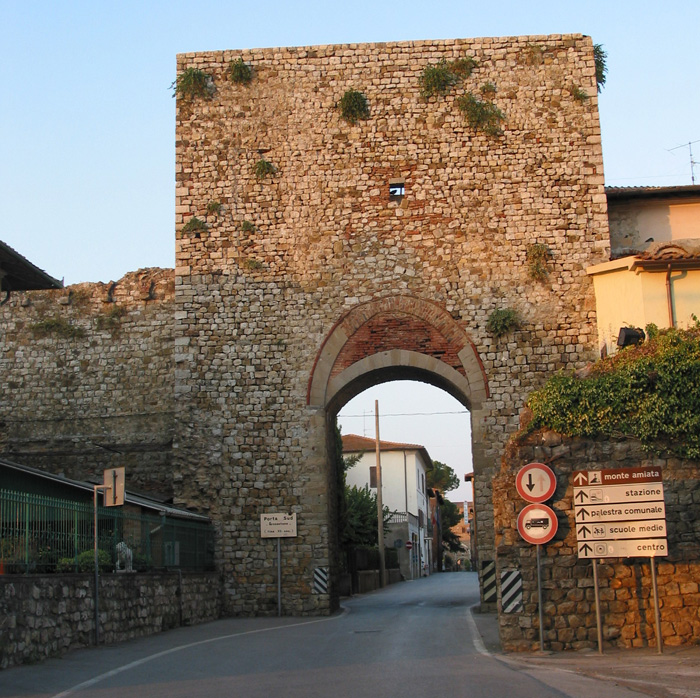 |
|
Civitella Paganico |
|
|
Civitella Marittima, Paganico, Monte Antico, Pari, Casenovolo and Petriolo are part of Civitella Paganico. The best way to enjoy the numerous beauty spots of Civitella Paganico is by means of the old roads that cross the countryside and reveal its unspoiled beauty. Don't forget to visit the Tenuta di Paganico, one of the largest and finest biological farms in Tuscany.
|
#poderesantapia La Tenuta di Paganico è situata alle porte de Paganico. Antico feudo degli Aldobrandeschi e marchesato dei Patrizi, oggi è un’azienda agrozootecnica biologica che si estende su ben 1.500 ettari e, dal 1922, appartenente alla famiglia Uzielli.
|
| Civitella Marittima, the principal town of Civitella Paganico, stands on a hill covered in cypress and olive trees and commands a view of the Maremma plain and the Tyrrenian coastline. The village, home to 350 people, has Etruscan-Roman origins but most of its buildings date back to the Middle Ages. It was the seat of the Aldobrandeschi family who left an important heritage of Romanesque architecture such as the Badia of San Lorenzo on the Lanzo, or Badia Ardenghesca. Along with Paganico, the town fell under the dominion of the Sienese at the beginning of the 14th century. A few kilometres from Civitella Marittima, along the road that leads from Grosseto to Siena, you can find the ancient monastery known as Badia Ardenghesca or Badia al Lanzo, because it is built near the creek of the same name. San Lorenzo dell'Ardenghesca (it) |
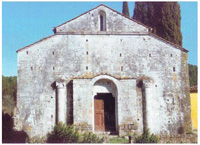 Badia di San Lorenzo |
|||
| Founded by the powerful Ardengheschi family at the beginning of the 12th century, it is one of the most beautiful examples of Romanic architecture in the Maremma area. The monastery, which is located along the so-called Via del Sale which led from Siena, through Paganico, all the way to Port’Ercole, had already been abandoned in the middle of the 15th century and all of its goods had been passed on to the Augustinians of the Sienese convent St. Mary of the Angels. The buildings then fell into ruins and almost completely disappeared. Today, the most well-preserved building is the church, partially recovered in restoration work done in 1967. The building still has a single, central nave and its ancient facade. Its decoration is similar to that of the famous Abbey of Sant’Antimo. Particularly worth noting are the capitals of the columns that flank the portal, which are adorned by monstrous figures and unusual animal figures. The Abbey can be reached from Civitella Marittima, exiting the S.S. 223 for the road linking the residential area to the old Petriolo Road. Not far from Civitella Marittima, and clearly visible from the village, is the famous Castle of Poggio alle Mura, also known as Villa Banfi and home to one of the most popular producers of Brunello di Montalcino DOCG wine. Castello Monte Antico, just a few kilometres from the province of Siena’s border, is one of the most evocative settlements in the territory of Civitella Marittima. A winding, cypress-lined road leads to the castle and the view from the top is among the most beautiful in Tuscany. A steep crag runs down to the plains below where the slowly-moving Ombrone snakes its way, and the massive shape of Monte Amiata can be seen in the background. Since the 9th century, this town has had a fortress and an important parish church, which was managed by the Sienese nuns of Montecelso, before being claimed by the monks of San Lorenzo dell’Ardenghesca. Monte Antico is surrounded by a ring of walls and it includes the noble palace, which has been renovated repeatedly over the centuries. Externally, it has an interesting facade with double lancet windows; on the lower part, you’ll find a series of arches and a gallery with an entry staircase. The interior contains interesting frescoes. The small village, which is located within the walls, comprises various buildings, including the ancient stables and large rooms covered by cross vaults. After years of abandonment, the castle has now been converted into a hotel that also hosts cultural initiatives and conferences. The origins of the castle Castello di Monte Antico date back to the 10th century. The castle is situated on the top of a hill, at the confluence of the rivers Orcia and Ombrone. For centuries it was part of the defensive system which the Sienese Republic had created on the borders. The castle has had a very complex history, afflicted by sieges and sorties, plundering and splendour, lasting until the Sienese Republic enlarged their territory until the sea. Only at that time, Monte Antico could find a peaceful existence and in accordance with the surroundings which were reclaimed and then planted with vines. In the memories of the family "Piccolomini" was noted that in 1337 the castle came into the possession of the Lords "Nicolò Monsignori di Siena", followed by "Cione d'Alessandro Tolomei". This family assigned the villa for young boarders of the seminary of the Holy George ("Seminario di San Giorgio") to pass their holidays there. During the 16th century, the territory was connected with Montalcino; then the administrative reforms of the Grand Duke Leopold, annexed it with the sea province. It was became steadily part of the commune of Civitella. The wine coming from Monte Antico has the D.O.C. - denomination. |
||||
![The Ombrone River in Paganico, part of Civitella Paganico [1]](https://upload.wikimedia.org/wikipedia/commons/thumb/9/9b/OmbronePaganico1.JPG/2048px-OmbronePaganico1.JPG) |
||||
The Ombrone River in Paganico, part of Civitella Paganico [1] |
||||
| Terme di Petriolo, are thermal baths and natural hot springs, known and appreciated since the Roman times and very popular among noble people and members of the clergy in the Middle Ages. The fort of Petriolo was located at the northern limit of Civitella Paganico, at the border of the Borough of Monticano. The authentic thermal baths of Petriolo date back to 1230. Known already to the ancient Romans and mentioned by Ugolino of Montecatini in his Tractatus de Balneis for the therapeutic properties of its suphureous waters. In 1404 the fortification of Bagni di Petriolo was completed, the only remaining example of fortified thermal springs. The Baths of Petriolo were frequented by such illustrious figures as Pope Pius II Piccolomini and Lorenzo de' Medici.
|
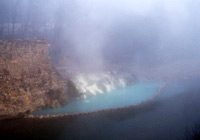 The thermal baths of Petriolo |
|||
|
|
||||
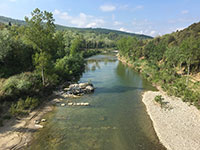 |
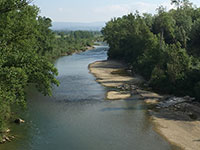 |
|||
Paesaggio della Valle dell'Ombrone, la parte terminale della Val d'Orcia tra le province di Grosseto e Siena
|
Il fiume Ombrone nei pressi della frazione di Sasso d'Ombrone | Il fiume Ombrone nei pressi della frazione di Sasso d'Ombrone | ||
|
|
||||
 |
 |
 |
||
Rovina nei pressi dei Bagni di Petriolo
|
Acqua termica di Bagni di Petriolo, Monticiano | Rovine delle mura cittadine di Bagni di Petriolo, Monticiano | ||
| A particularly interesting trip is the one that follows the old State Road that connected Siena to Grosseto. This begins at Paganico and continues to the thermal spring at Petriolo (Bagni di Petriolo). It is a road associated with a history that dates back to antiquity and with the visits of famous historic figures such as Pope Pius II Piccolomini in 1460. By following this road north, you can see the highest mountain of the area, the so-called poggio dei Lecconi at an altitude of 600 metres. Alternatively, if you leave Paganico by the beautiful Sienese Gate, you can follow another road that will also take you to Monte Amiata. On leaving Paganico on the old State Road and travelling in the direction of Petriolo you will find a turn-off, after two kilometres, that leads to Monte Antico. This beautiful little town nestles at the foot of a hill on which is located the ancient castle. Today the castle has been transformed into an elegant hotel, with magnificent views of the Ombrone valley as it slowly winds its way at the foot of Monte Amiata. On leaving the castle of Monte Antico a narrow winding road will take you past woods and fields, to Casal di Pari. Along this road you will also pass the castle of Casenovole, which is well worth a stop. If you continue on the State Road and do not take the turn-off to Monte Antico, you will pass small hamlets and groups of houses isolated in a landscape that recall the past history of this region. The ancient hamlet of Dogana, is on the right of this road and a little further on there is a turn off to the left. This recently paved road passes by the ancient Abbazia (Abbey) Ardenghesca of San Lorenzo , and will finally take you to the town of Civitella Marittima. If you decide not to turn off to Civitella Marittima but continue along the Start Road you will arrive at Casal di Pari, a tiny hilltop village where interesting archaeological discoveries from the Etruscan-Roman era have been made. Approximately 2 km further north is the village of Pari, with its beautifully preserved medieval appearance. The Farma valley can be seen from this vantage point. Pari also reminds us that, unlike the other towns and villages of the Borough, it retains a strong memory of its former connection to Siena. This can be seen in the exceptional degree of conservation of its buildings. Continuing along the old Grosseto-Siena road you will finally reach the Bagni di Petriolo, an ancient thermal bath. It is still visited today because of the medicinal properties of the sulphur water spring.
|
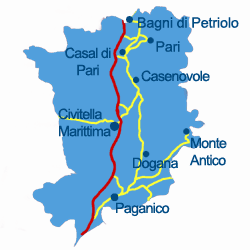 |
|||
 |
||||
Paganico, the Corso Fagarè and Cassero Senese[2]
|
||||
In the comune of Civitella Paganico, there are two other picturesque castles in a nice panoramic position: the Castle of Monte Antico and the Castle of Casenovole. |
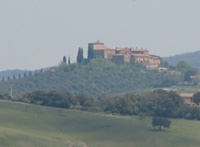 Castle of Casenovole |
|
Campagnatico is a typical Medieval town, both in its urban structure and in its strategic position. It stands on a rise, planted with olive trees, that in the east drops off sharply over the Ombrone Valley. The ancient castle belonged to the Aldobrandeschi family of Sovano and was mentioned in Canto XI of Dante’s Purgatory Comune Campagnatico From the old city’s Piazza Garibaldi, you can take via Roma and reach the elongated walls that enclosed the two peaks which stood opposite the fortress in the north and the church of St. John the Baptist in the south.
|
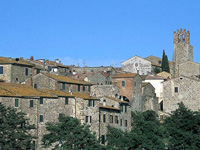 |
|
| Dogana is a small village immersed in the countryside of the Maremma, a tiny group of houses on the top of a hill surrounded by cultivated fields and olive groves. Pari is a medieval hamlet on a hilltop which has preserved its original structure. The views from the village over the Ombrone and Farma valleys are breathtaking and the Petriolo hot springs are only a few kilometers away. |
 |
|
Pari, Civitella Paganico, panorama
|
||
|
||
In August 2007, archaeologists discovered a perfectly preserved Etruscan tomb dating to some time between the first and third centuries B.C.E, or nearing the end of the Etruscan period. According to Reuters, finding an intact tomb of this sort is extremely rare.
|
||
